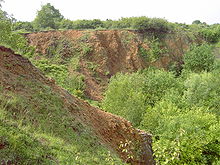Brockenberg nature reserve
The Brockenberg nature reserve is located in the Aachen city region in North Rhine-Westphalia . It covers an area of 32 hectares , lies at a height of 260 mm above sea level and is located southeast of the Stolberg district of Büsbach .
The Brockenberg is one of 37 nature reserves currently belonging to the city of Stolberg (Rhineland).
geology
The largest part of the Brockenberg nature reserve, like the regionally neighboring areas Schlangenberg , Bärenstein and Schomet, belongs to an area located on a limestone ridge. This limestone was deposited in the Devonian about 400 million years ago.
In the course of the following millions of years, the limestone layer came to the surface of the earth and was partially removed by erosion . Metal-containing solutions penetrated into the porous material and formed over Primärerze such as sphalerite or marcasite the Sekundärerz calamine .
While the limestone ridge reaches as far as Belgium , the galmei-containing area is limited to the area around Stolberg (Rhineland), Aachen and Kelmis .
history
The history of the Brockenberg nature reserve is closely related to ore mining. Galmeierz, which was used in the Stolberg works for brass production, has been mined in the area since the time of the copper masters . The numerous depressions in the nature reserve that can still be seen today are evidence of the mining technology used in Pingen at that time . At the same time, the Lucia shaft was below the site. A building from this period still exists, but is now used as a residential building, in an isolated position on an area on the edge of the nature reserve.
In 1889 the calamine was stopped. The reasons for this were the war, the mining method that has meanwhile become unprofitable, the changed shareholder structure of the owner, the " Alliance ", as well as partially exhausted ore reserves.
The limestone in the ground was also used by the owner of the site, Westdeutsche Kalk- und Portlandzement AG. The Schennskull quarry was exploited until the 1970s before it was shut down. After years of fallow it served as a welcome space to dump debris and earth. As in the rest of the Brockenberg area, there was no renaturation.
Nature reclaimed the area over time. In the meantime, a layer of plants has covered most of the quarry area and the edges of the demolition are hidden by rows of trees.
flora
A study from 1999 determined the following area composition: 20% of the total area is dry grassland and steppes, 15% moist and mesophilic grassland, another 15% deciduous forest. The remaining 55% are classified as mining and landfill areas.
The reserve Brockenberg provides a Refugialbiotop for endemic Galmeiflora. While the usual plants to by zinc , cadmium and lead contaminated land little vegetation way have had at the places where ores came to light the Galmeiparagenese a Galmeiflora train. It exists here in a much purer and more pronounced form than in the Schlangenberg nature reserve, which is larger in area .
Typical calamine plants such as the yellow calamine violet Viola lutea ssp can be found on the areas containing calamine . calaminaria , the calamine carnation Armeria maritima ssp. calaminaria , the calamine spring Miere Minuartia verna ssp. hercynica or Calmei-Hellerkraut Thlaspi calaminare , which is also called Calmei-Täschelkraut .
The thyme silk Cuscuta epithymum , among other things, grows on the poor soils, especially in the quarry area .
fauna
Due to its diversity, the Brockenberg nature reserve includes various biotopes. The galmei surfaces represent an optimal habitat for an abundance of butterflies. These include the green hairstreak Callophrys rubi , the dwarf blue Cupido minimus but also the forest blue Cyaniris semiargus or the purple gold butterfly Lycaena hippothoe .
In addition to butterflies, the areas also offer a habitat for numerous horrors. These include the wart- biter Decticus verrucivorus , the two-colored bite- bug Metrioptera bicolor and the short-winged bite- bug Metrioptera brachyptera . But the heather grasshopper Stenobothrus lineatus is also one of the species represented here.
The few bushes on the site serve as a vantage point for the red- backed lanius collurio . Woodlarks Lullula arborea can be found as ground brooders both on the calamine areas and in the quarry area. Various day and night birds of prey live in the remaining rock faces, while the smooth snake Coronella austriaca can be found in the damp areas of the quarry alongside various amphibians .
Threat to the nature reserve
The nature reserve is extremely endangered. In addition to a neighboring tar gravel plant, the nearby living area is responsible for this. Pedestrians leave the paths, dogs roam the area, destroy the rare plants, nests of ground-nesting birds and the unique habitat. Although the quarry area is cordoned off, pedestrians manage to gain access here too, threatening rare ground-nesters.
literature
- The district administrator of the Aachen district (ed.): Aachen district landscape plan: Stolberg / Roetgen . February 28, 2005.
- District government Cologne (Ed.): Nature reserves in the administrative district of Cologne . August 31, 2004 ( nrw.de [PDF; 800 kB ; accessed on May 6, 2007]).
- Commission of the European Community (Ed.): NATURA 2 0 0 0 Territory No . : DE 5203-303 . May 27, 1994 ( naturschutz-fachinformationssysteme-nrw.de [PDF; 540 kB ; accessed on May 6, 2007]).
Web links
- "Brockenberg" nature reserve (ACK-010) in the specialist information system of the State Office for Nature, Environment and Consumer Protection in North Rhine-Westphalia
- Area name Brockenberg
Coordinates: 50 ° 44 ′ 59 " N , 6 ° 13 ′ 53" E



